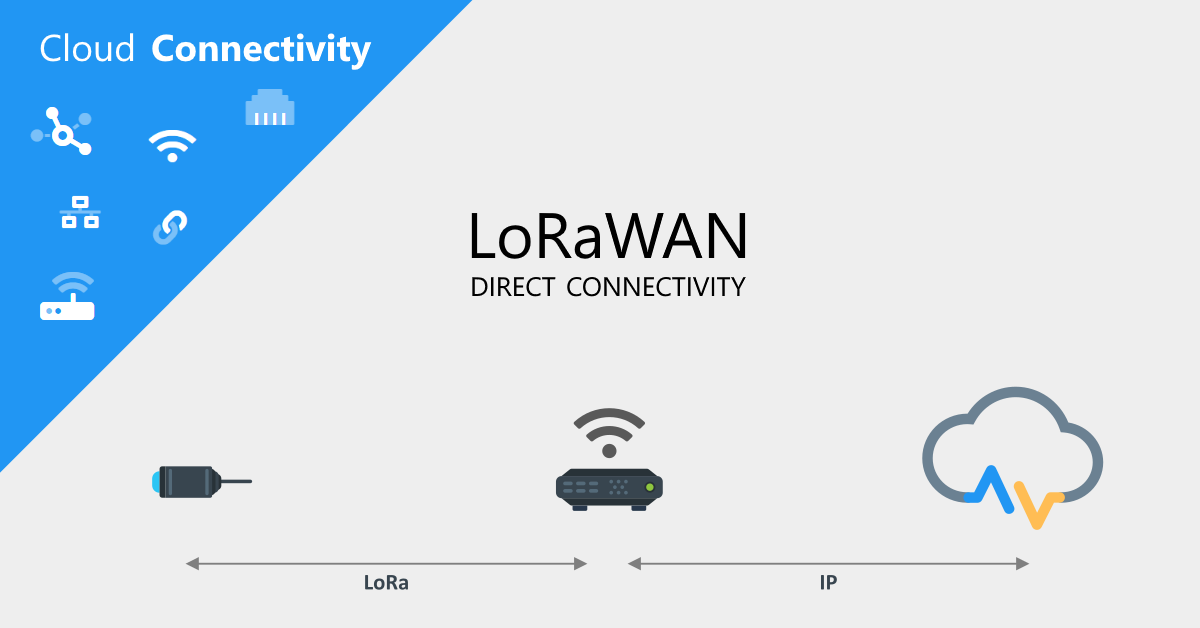Is there no network or power supply at your measuring point or is the cabling too complex? With LoRaWAN IoT sensors, you can conveniently record measured values wirelessly. Now new: directly in AnyViz at no extra cost.
The low-power wireless network is becoming increasingly popular. Inexpensive sensors with a battery life of 2 to 15 years transmit their measured values up to 10 km to the nearest gateway. This reduces the effort required for commissioning to a minimum and even the most remote locations can be reached. This has been possible for some time via the community-based The Things Network. Now integration is possible without any further dependencies, as AnyViz now acts as a compatible network and application server.
How LoRaWAN works
Each device sends its measured values at an individual interval or on an event-driven basis. Nearby gateways receive the message and forward it to the configured network server. Unlike with mobile radio or WLAN, no configuration is required on the device and there are no network charges.
Previously, a network server such as The Things Network (TTN) was usually used, which decrypted and interpreted the messages and forwarded them to a cloud solution such as AnyViz. Now AnyViz itself can be configured as a network server.
Advantages of direct integration
The devices are managed centrally in AnyViz. This eliminates the frequent switching between AnyViz Portal and The Things Console and saves costs of €190/month to €300/month. We have also reduced the number of clicks required to create new devices to a minimum.
The messages are also interpreted entirely in AnyViz. The AnyViz team takes care of the so-called PayloadFormatter. If a formatter is not available for the desired device, a short e-mail is sufficient to order the development at no extra cost.
Bidirectional communication is now possible without further ado. This means that actuators can also be controlled remotely, as AnyViz can automatically generate and send downlinks.
You have full control over the LoRaWAN network and are not dependent on external gateways or other network services.
Getting started is easy
To integrate the wireless sensors, only a gateway is required, which has “lora.anyviz.io” as the network server with the UDP port 1700. The devices are onboarded as usual via OTAA (Over-The-Air-Action) by entering the DevEUI, JoinEUI and AppKey. As soon as the device sends a join request, the integration is complete.
Note: Most LoRaWAN gateways allow the configuration of multiple network servers. This allows you to use AnyViz and support the TTN community at the same time.
LoRaWAN gateways are available from around 150€. Contact us for recommendations.
The best of both worlds
Coupling via LoRaWAN offers many advantages, but also disadvantages: It is usually not possible to record data to the second and the cost advantage is only given if the number of measured values is manageable. With LoRaWAN, Universal Cloud Adapter and MQTT, the AnyViz portal offers a wide range of interoperable connection options. Direct PLC connections, edge gateways and LoRaWAN devices can be combined in the same project. With the option of defining a tag as the source, LoRaWAN measured values can be transferred to the controller or vice versa: LoRaWAN actuators can be switched via the controller.
LoRaWAN use cases
LoRaWAN is a promising technology that offers valuable benefits in numerous industries. In building management, meters, temperature sensors or leakage sensors in remote buildings can be monitored without a conventional network connection. In water management, remote elevated tanks, spring shafts or wells can be easily integrated. LoRaWAN energy meters enable more efficient energy management. Environmental sensors also help to optimize irrigation and farm management in the agricultural sector.
Secure through end-to-end encryption
A device sends its measured values without a SIM card and without network credentials. Every gateway in the vicinity forwards the data to one or more network servers. How can this be secure? Quite simply: through end-to-end encryption.
In a LoRaWAN network, the data from the device is encrypted before it is even sent. This encryption ensures that only the intended recipient, who has the appropriate key, can read the data. Even if a gateway or network server is compromised, the data remains protected as it can only be decrypted by the application server. This robust security architecture enables sensitive data to be transmitted reliably and securely, even in environments with potentially insecure network infrastructures.
Growing LoRaWAN device directory
We expand our device directory with every new project. You can already use many LoRaWAN devices directly today. Here are a few examples:
- Almost all ELSYS devices
- Adeunis PULSE, ANALOG and TEMP
- Energy meters from Herholdt Controls
- Thermokon devices
- Level measurement with VEGA radar sensors
- MClimate Vicki thermostats
- Selected Dragino devices
Disclaimer: AnyViz is compatible with the LoRaWAN protocol, but is neither certified nor officially supported by the LoRa Alliance.


